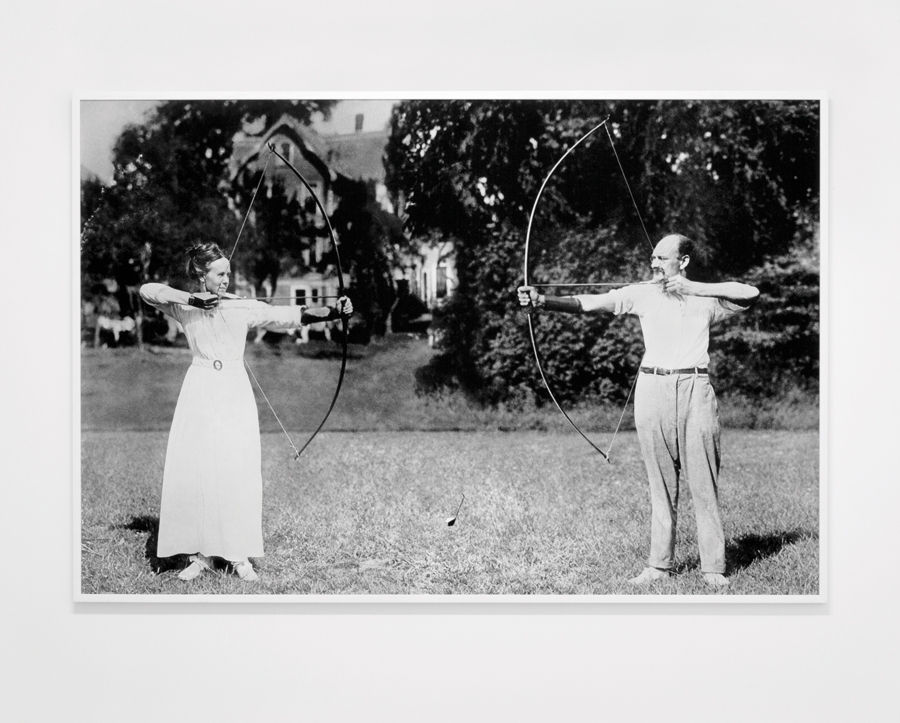Our cultural epoch is curiously lacking in the type of existential analyses that characterized other periods of crisis in the modern age. Galleries and museums are full of works that echo our financial malaise, either by mimesis of capitalist processes or criticism of the political and financial institutions that underpin them; but the dispiriting effect that economic or spiritual crises have on the individual is little explored by comparison. Against that trend, and across two rooms, EP – or ‘extended play’ – presents five photographic works selected from five different projects undertaken between 2011 and 2013 by the Rome-based Lamberto Teotino. All in black and white and all comprising manipulated photographs printed on Hahnemühle cotton paper, these revisit a tendency to reflect on the dark aspects of the human psyche as well as the human individual’s embedding within time: philosophical subjects recalling the influence that Heidegger and Sartre had on postwar literature and art.
L’ultimo Dio (The Last God, 2012–13) sums up well Teotino’s overall tendency to depict the cold abstraction of itself that humanity has become in our postindustrial age. This large-scale portrait of a typical patriarchal figure (one could imagine him being a psychologist, scientist, banker or industrialist), his features obscured by a type of leafy organic growth (and so evoking the work of John Stezaker), appears to symbolise a possession of the self by an empty imposter. In the same room, Wormhole (2012–13) depicts a rugged landscape featuring a grazing cow cut with precision down the middle, revealing a gap through which the sea and land behind can be seen. This manipulation – which is part of the artist’s reflection on quantum mechanics and the ways in which the laws of physics are impervious to human and animal life – is unsettling for its subtlety. As here, the images on display – despite their manipulation – leave the viewer to reflect less on images that are skewered and more on a skewered reality: one which the images depict without exaggeration.
Mr and Mrs Smithee (2013), the most recent and biggest (at 240 by 160 cm) of the works on display, takes two images of a male and female archer respectively, each at the point just prior to releasing their bows, and places them opposite and facing one another, each bearing cold expressions. Poised to shoot at one another while standing in the setting of an otherwise tranquil urban garden the subjects hint at the ease with which humanity pits itself against itself, on both the societal and personal levels. The image manipulation itself is barely visible, giving the image a slight eeriness. Something is not right, but it’s unclear if it’s the shadows or the scale of the subjects. Yet the truly worrying aspect of this exhibition as a whole is its cold presentation of the human form, devoid of sentimentality.
Sistema di Riferimento Monodimensionale (One-Dimensional Coordinate System, 2011–13) depicts five female dancers on stage, the portion of the photo at the level of their eyeline having been cut out and the brow slightly lowered so as to clinically and precisely remove part of each of the women’s heads. The subtlety of the manipulation initially evades detection until the viewer realizes that each woman has been very precisely and deliberately deformed. The work is from a series in which the aforementioned ‘cut’ is used as a simple device to symbolize the notion of folds in spatiotemporality. While the science is reduced to a symbolic form, the fragility of humanity in a universe it doesn’t fully understand is well conveyed, with zero respect for the ethical niceties that we look to in order to provide solace for a bleak reality. That reality is here conveyed, via Teotino’s research, with almost autistic clarity.
This article was originally published in the March 2014 issue.
